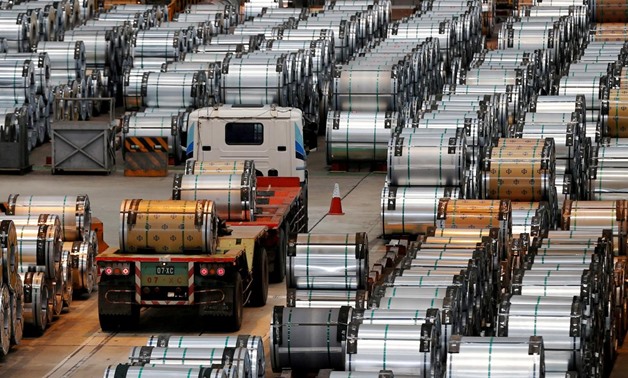
FILE PHOTO: A truck drives past rolls of steel inside the China Steel Corporation factory, in Kaohsiung, southern Taiwan August 26, 2016. REUTERS/Tyrone Siu/File Photo
BEIJING - 9 September 2017: China’s producer price inflation accelerated more than expected to a four-month high in August, fueled by strong gains in raw materials prices and pointing to strong, sustained growth for both factory profits and the economy.
Consumer inflation also quickened more than forecast to a seven-month high, amid signs that upstream price gains are trickling through, but analysts said price gains remain modest and there is little pressure on the central bank to tighten policy further.
“The unexpected rise in both CPI and PPI suggests that there is little hope China’s monetary policy could see some relaxation before the end of this year,” Zhou Hao, a Singapore-based analyst at Commerzbank.
“We believe that the market has underestimated the inflationary pressure facing China’s economy, although inflation is unlikely to surge in the foreseeable future. That said, onshore rates are still on the rise,” he said, referring to higher financing costs.
China’s producer price index (PPI) rose 6.3 percent in August from a year earlier, from 5.5 percent in July, the National Bureau of Statistics said on Saturday.
Analysts polled by Reuters had expected producer inflation would edge up to 5.6 percent, its first pickup in six months.
On a month-on-month basis, the PPI rose 0.9 percent.
The price data added to a long list of upside surprises for the world’s second-largest economy this year, which has so far defied analysts’ expectations of a slowdown.
A year-long, government-led construction boom, a resilient property market and a recovery in exports have offset the expected drag from a regulatory crackdown on riskier types of financing, which is slowly driving up borrowing costs.
“The pickup in PPI shows that demand remains steady, and we expect third-quarter economic growth to remain steady from the first half,” said Zhang Yiping, an economist at Merchants Securities in Shenzhen.
With the industrial sector in high gear, the economy grew by a faster-than-expected 6.9 percent in the first six months of the year.
If activity remains relatively solid in coming months, China’s economic growth could accelerate for the first time in seven years in 2017. Last year’s pace of 6.7 percent was the slowest in 26 years.
“MAN OF STEEL”
China’s industrial firms have been posting their strongest profits in years as the building boom fuels demand and prices for everything from cement and steel to glass and copper wiring.
Its commodities futures markets have rallied hard and continued to surge through August, boosted by strong restocking demand and government pledges to shut inefficient and highly polluting mines and plants, which has underscored concerns over tight supply heading into winter.
Activity in China’s steel industry expanded in August at the fastest pace since April 2016, reflecting high levels of production and low inventory.
Prices of ferrous metal smelting and rolling processing industries jumped 29.1 percent in August on-year while prices of non-ferrous metal sectors grew 16.3 percent, and prices of the oil processing sector rose 16.8 percent, the latest data showed.
However, some analysts say rising prices have mainly benefited state firms which dominate upstream industries, while smaller companies further along the supply chain have been burdened by sharply higher raw materials costs.
Likewise, some economists say sharply higher commodity prices are also flattering China’s import data, possibly exaggerating the strength of domestic demand. Imports rose 13.3 percent in August, more than expected, data showed on Friday.
And, it still seems too early to tell if suddenly cash-rich “smokestack” industries are putting the money to use by paying down massive levels of debt, an issue that Beijing has made a top priority this year as it looks to contain financial risks.
GRADUAL SPILLOVER INTO CONSUMER PRICES
China’s strong appetite for resources such as iron ore has helped fuel a reflationary pulse in the manufacturing sector worldwide, producing synchronized growth in many developed and developing economies alike.
But despite the country’s growing string of data surprises, analysts continue to maintain that factory-gate prices will lose steam eventually if regulatory tightening continues and consumer and corporate borrowing costs inexorably rise.
Saturday’s data also suggested that the year-long gains in producer prices are starting to percolate through to the broader economy, but at a modest pace, which will be welcome news to the central bank.
China’s retail inflation has been quite mild this year, raising questions about the accuracy of other official data that showed robust economic activity.
But consumer inflation rate quickened more than expected to 1.8 percent in August from 1.4 percent in July, the first time it has accelerated in three months.
The consumer price index (CPI) had been expected to rise 1.6 percent on-year.
Food prices, the biggest component of the consumer price index (CPI), fell 0.2 percent from a year earlier.
Non-food price inflation quickened to 2.3 percent in August from 2 percent in July.
The government is targeting economic growth of around 6.5 percent this year and inflation of 3 percent, so the latest reading is still well within the central bank’s comfort range.
China will release further August data next week on bank lending, industrial output, retail sales and investment, which are expected to point to solid growth.


Comments
Leave a Comment